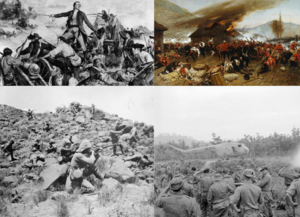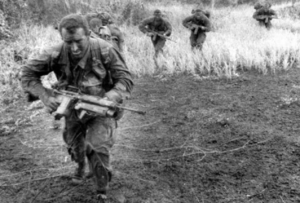Arcer Bush Wars
| Arcer Bush Wars | |||||||||
|---|---|---|---|---|---|---|---|---|---|
| Part of Arcer Colonial Expansion | |||||||||
 Photos from the Arcer Bush Wars (Clockwise from top left); Carnish settlers defend Fort Moorden in 1798 as part of the First Bush War; Members of 1st Battalion, Royal Arcerion Regiment in 1848 defend their position against an indigenous assault on the Easthampton Settlement during the Second Bush War; Members of the Royal Easthampton Borderers skirmish with native irregulars during the Third Bush War; Infantrymen from the Northlea Rifle Regiment evacuate wounded personnel in a remote part of Northlea in 1968 as part of the Fourth Bush War | |||||||||
| |||||||||
| Belligerents | |||||||||
|
|
Indigenous peoples | ||||||||
The Arcer Bush Wars were a series of military conflicts that occured from the initial Carnish settlements in Arcerion being raided by Indigenous tribes to the prolonged campaigns by the Arcer Militia and Regular Forces to establish a Gaelic and Anglic colony in South Crona by pushing further inland and defending Arcer settlements.
History
Background
Carna
Arcerion
Indigenous Peoples
First Bush War (1794-1801)
Kurst + Chester-on-Moore as small colonies, kicks off and the Arco colony is small, by end of war nearly doubled the land owned by the settlement
Causes
Forces
War
Aftermath
Second Bush War (1839-1850)
Establishment of Kinnaird, Easthampton, and Craigfearn has occured, Moorden borders mostly done, South end of Norham is established. War is the main driver into Northlea and has the "River" campaign into the heartland
Causes
Forces
War
Aftermath
Third Bush War (1898-1904)
Norham fully established, same with Moorden. masive campaign to push Northlea to its current boundaires, and the landings and colonizing of Foxhey happened in the 1880s
Causes
Forces
War
Aftermath
Fourth Bush War (1964-1975)

The Fourth Bush War was a prolonged conflict on the Arcerion border, involving multiple insurgent, guerrilla, or irregular factions, indirectly or directly supported by Telokona, Kelekona, and Titechaxha. It heavily involved all three branches of the Arcerion Armed Forces, and including the rapid rise of modern special forces with the Arcerion Commando Regiment taking a prominent role with its cross-border raids and the Arcerion Rangers conducting long-range patrols behind the operational area.
Causes

The Fourth Bush War began from consistent Arcer farming exports causing a massive economic collapse in Telokona during the spring of 1964, where it was unable to compete with the higher quality and more readily available Arcer grain products. Seeking to destabilize the ability of the Arcer government and its economic power, Telokona began providing arms, supplies, and training to the Free Telokonese People's Movement (FTPM), a socialist group operating in the Innis River Basin (IRB). Continued economic expansion by Arcerion, including the opening of a major shopping port in the city of Oakham, led to an increases in Telokonese support for insurgent forces attacking farmers and rail lines. In solidarity, and seeing the opportunity to cripple or damage a strategic rival, Kelekona and Titechaxha also began mirroring this process, and by 1966 there was a sharp rise in not only attacks on farms, farmers, and rail infrastructure, but government buildings and key civil infrastructure.
Forces
Arcerion
The Arcer Armed Forces at this time were undergoing a period of austerity and force reduction in the wake of the Second Great War. With no major strategic enemies, only regional rivals, the Army had shrunk to its smallest size since 1900, and had only five regular army brigades, with the rest being reserve status or on "short activation" status, wherein for all intents and purposes they were reserve brigades. The Arcer Air Fore also was struggling with budget cuts and austerity measures, as its ability to bring in newer fighter jets, helicopters, and modern radar systems was limited not only due to federal funding, but due to their chronic manning shortages caused by a strong private and public sector employment strategy, making military service the least attractive option at the time. The Royal Arcer Navy played a more limited role in the conflict, but was able to conduct its primary function of ship interdiction and helping to stem the flow of supplies to Kelekona and Telekona through their ports and weapons smuggling ships. Over the course of the war, the Army would introduce new tactics and techniques, as well as modern weaponry for the infantry and supporting arms, and the Air Force would revitalize its rotoary-wing asets and close-air-support platforms. By the war's end, the Army was at a standing eight brigades, with a ninth undergoing readiness and evaluation trials, with companies of reservists regularly deploying into the area of operations for shorter 3-month deployments. New air bases, increased fire control systems, and modern innovations such as precision munitions and early examples of laser-designation and night fighting equipment were all introduced into the Arcer Armed Forces during this period.
Irregular and Guerilla Forces
Originally the Free Telokonese People's Movement (FTPM) was several hundred strong, but by the war's end would number in the thousands. It would soon have a more militant and radical communist offshoot, the Telokonan Worker's Army for a Free Crona (TWAFC). In the smallest operational zone, Operation Kiln, Kelekona supported the Kelekonan Militia for Free Indigenous People (KMFIP). The largest operational area was reflected by the fact that there was three separate terrorist organizations operating there, all supported by Titechaxhan intelligence and security forces. The Free Indigenous Army (FIA), Movement for a Liberated Aboriginal People (MLAP), and the Riverland Tribe Worker's Party (RTWP) numbered by the late-1960s into the thousands. These forces varied widely in terms of equipment, training, experience, and leadership. In general, they were effective as a decentralized quasi-insurgent force. Unable to secure popular support from the Arcer populace en masse, these groups resorted to brutal acts of violence and further isolated themselves from both the native indigenous populations as well as naturalized Arco citizens. As a regular fighting force trying to engage Arcer units in conventional battles, they were quickly destroyed by a combination of artillery fire, air strikes, and aggressive counter attacks by the tactically and operationally superior Arcer units. However, leadership, particularly in the Operation Teflon zones were adept at guerrilla fighting and insurgent-like tactics, making it incredibly difficult to ensure all Arcer farmrs and key points were protected, owing to the long length of the Fourth Bush War.
War
Early Stages
Operation Terrace
Operation Kiln
Operation Teflon
Aftermath
Legacy
legacy stuff
Effect on Arcer Culture and Politics
Arco-Indigenous Relations
In Popular Culture
At least 1 movie a la Zulu
At least 1 movie Vietnam-ish
documentary about first bush war
reenactments of first bush war